The Development and Performance Assessment of Palm Kernel Nut Oil as a Cutting Fluid for the Turning of AA6061
Abstract
1. Introduction
2. Materials and Method
2.1. Sample Collection and Processing
2.2. The Procedure for the Extraction of Palm Kernel Seed Oil
2.3. Physio-Chemical Properties of Palm Kernel Nut Oil
2.3.1. Density and Specific Gravity
2.3.2. Viscosity
2.3.3. Moisture Content
2.3.4. Acid Value
2.3.5. Free Fatty Acid Weight Percent
2.3.6. Saponification Value
2.4. Machining Operations
2.4.1. Determination of Surface Roughness and Cutting Temperature
2.4.2. Determination of Optimal Cutting Parameters
2.4.3. Evaluation of Signal-to-Noise (S/N) Ratio and Grey Relational Analysis for Turning Workpiece
3. Results and Discussion
3.1. Characterization of Palm Kernel Nut Oil (PKNO)
3.2. Discussion on Analysis of Experimental Data
3.3. Analysis on the Impact of Cutting Conditions on Surface Roughness
3.4. Effect of Cutting Parameters on Cutting Temperature
3.5. Main Effect Plot
3.6. Evaluation of Analysis of Variance
4. Conclusions
- The superior machining performance of palm kernel nut oil (PKNO) compared to mineral oil can be attributed to its favourable physicochemical properties. PKNO possesses a higher viscosity index, better lubricity, and a higher flash point, which contribute to enhanced lubrication, reduced friction, and lower tool wear during machining. Additionally, its biodegradable nature and polar functional groups improve its ability to form an effective lubricating film, thereby reducing cutting forces and improving surface finish.
- The data obtained for surface roughness for dry machining, palm kernel oil, and mineral oil lubricants were 0.164 ± 0.070 µm, 1.327 ± 0.509 µm, and 0.584 ± 0.049 µm, respectively. In terms of surface roughness, palm kernel oil is the best with 71.8% improvement over mineral oil. Dry machining was poor in performance, and this was expected due to the absence of lubrication.
- It can be inferred from the results and discussions that the cutting temperature results for dry machining, palm kernel oil, and mineral oil lubricants were 36.10 ± 0.69 °C, 21.34 ± 0.59 °C, and 31.74 ± 0.53 °C, respectively. This shows that machining with PKNO cutting fluids reduced heat the most in the cutting zone.
- The values obtained for the optimum spindle speed, feed rate, and depth of cut are 660 rpm, 0.15 mm/rev and 1.00 mm for dry machining, 415 rpm, 0.15 mm/rev and 0.75 mm for palm kernel oil, and 415 rpm, 0.15 mm/rev and 0.75 mm for mineral oils, respectively.
- The ANOVA findings for GRG were used for estimating the percentage contribution of the input variables. When considering response minimization, the feed rate has the most impact on the grey relational grade for the turning process under MQL.
Author Contributions
Funding
Data Availability Statement
Conflicts of Interest
References
- Guntreddi, B.; Ghosh, A. High-speed machining of aluminium alloy using vegetable oil based small quantity lubrication. Proc. Inst. Mech. Eng. Part B J. Eng. Manuf. 2023, 237, 1999–2014. [Google Scholar] [CrossRef]
- Azarhoushang, B. Abrasive Machining Processes. In Tribology and Fundamentals of Abrasive Machining Processes, 3rd ed.; William Andrew: Norwich, NY, USA, 2021. [Google Scholar] [CrossRef]
- Bhattacharyya, B.; Doloi, B. Machining processes utilizing thermal energy. In Modern Machining Technology; Academic Press: Cambridge, MA, USA, 2020. [Google Scholar] [CrossRef]
- Hadad, M.; Hadi, M. An investigation on surface grinding of hardened stainless steel S34700 and aluminum alloy AA6061 using minimum quantity of lubrication (MQL) technique. Int. J. Adv. Manuf. Technol. 2013, 68, 2145–2158. [Google Scholar] [CrossRef]
- Kaewsaard, P.; Zhu, H.; Qi, H.; Tangwarodomnukun, V. Laser surface masking of stainless steel for electrochemical machining process. Int. J. Adv. Manuf. Technol. 2021, 116, 1141–1150. [Google Scholar] [CrossRef]
- Salah, N.B.; Ghanem, F.; Atig, K.B. Numerical study of thermal aspects of electric discharge machining process. Int. J. Mach. Tools Manuf. 2006, 46, 908–911. [Google Scholar] [CrossRef]
- Gostimirovic, M.; Kovac, P.; Sekulic, M. An inverse heat transfer problem for optimization of the thermal process in machining. Sadhana-Acad. Proc. Eng. Sci. 2011, 36, 489–504. [Google Scholar] [CrossRef]
- Khan, T.; Broderick, M.; Taylor, C.M. Investigating the industrial impact of hydraulic oil contamination on tool wear during machining and the development of a novel quantification methodology. Int. J. Adv. Manuf. Technol. 2021, 112, 589–600. [Google Scholar] [CrossRef]
- Hof, L.A.; Wuthrich, R. Glass precision micro-cutting using spark assisted chemical engraving. Adv. Ind. Manuf. Eng. 2021, 3, 100056. [Google Scholar] [CrossRef]
- Martin, C.R.; Untaroiu, A.; Xu, K.; Raman, S.M.M. A Study of the Efficacy of Flame Electrical Resistance for Standoff Measurements During the Oxyfuel Cutting Process. J. Manuf. Sci. Eng. 2022, 144, 071010. [Google Scholar] [CrossRef]
- Rosenkranz, A.; Costa, H.L.; Baykara, M.Z.; Martini, A. Synergetic effects of surface texturing and solid lubricants to tailor friction and wear—A review. Tribol. Int. 2021, 155, 106792. [Google Scholar] [CrossRef]
- Belhoussaine, O.; El Kourchi, C.; Harhar, H.; El Moudden, H.; El Yadini, A.; Ullah, R.; Iqbal, Z.; Goh, K.W.; Goh, B.H.; Bouyahya, A.; et al. Phytochemical characterization and nutritional value of vegetable oils from ripe berries of Schinus terebinthifolia raddi and Schinus molle L., through extraction methods. Food Chem. X 2024, 23, 101580. [Google Scholar] [CrossRef]
- Gokarn, N.; Kiran, K.N. Role of Lubricants in Industry: A Review. J. ISAS 2023, 2, 69–83. [Google Scholar] [CrossRef]
- Jeevan, T.P.; Jayaram, S.R. Performance evaluation of jatropha and pongamia oil based environmentally friendly cutting fluids for turning AA 6061. Adv. Tribol. 2018, 2018, 2425619. [Google Scholar] [CrossRef]
- Amiril, S.A.S.; Rahim, E.A.; Syahrullail, S. A review on ionic liquids as sustainable lubricants in manufacturing and engineering: Recent research, performance, and applications. J. Clean. Prod. 2017, 168, 1571–1589. [Google Scholar] [CrossRef]
- Soodoo, N.; Bouzidi, L.; Narine, S.S. Fundamental Structure–Function Relationships in Vegetable Oil-Based Lubricants: A Critical Review. Lubricants 2023, 11, 284. [Google Scholar] [CrossRef]
- Minami, I. Molecular science of lubricant additives. Appl. Sci. 2017, 7, 445. [Google Scholar] [CrossRef]
- Shah, R.; Woydt, M.; Zhang, S. The economic and environmental significance of sustainable lubricants. Lubricants 2021, 9, 21. [Google Scholar] [CrossRef]
- Bachchhav, B.; Bagchi, H. Effect of surface roughness on friction and lubrication regimes. Mater. Today Proc. 2020, 38, 169–173. [Google Scholar] [CrossRef]
- Alakhramsing, S.S.; de Rooij, M.B.; Schipper, D.J.; van Drogen, M. Elastohydrodynamic lubrication of coated finite line contacts. Proc. Inst. Mech. Eng. Part J J. Eng. Tribol. 2018, 232, 1077–1092. [Google Scholar] [CrossRef]
- Wong, V.W.; Tung, S.C. Overview of automotive engine friction and reduction trends–Effects of surface, material, and lubricant-additive technologies. Friction 2016, 4, 1–28. [Google Scholar] [CrossRef]
- Abegunde, P.O.; Kazeem, R.A.; Akande, I.G.; Ikumapayi, O.M.; Adebayo, A.S.; Jen, T.C.; Akinlabi, S.A.; Akinlabi, E.T. Performance assessment of some selected vegetable oils as lubricants in turning of AISI 1045 steel using a taguchi-based grey relational analysis approach. Tribol. Mater. Surf. Interfaces 2023, 17, 187–202. [Google Scholar] [CrossRef]
- Jeevan, T.P.; Jayaram, S.R.; Afzal, A.; Ashrith, H.S.; Soudagar, M.E.M.; Mujtaba, M.A. Machinability of AA6061 aluminum alloy and AISI 304L stainless steel using nonedible vegetable oils applied as minimum quantity lubrication. J. Braz. Soc. Mech. Sci. Eng. 2021, 43, 159. [Google Scholar] [CrossRef]
- Liu, G.; Wang, J.; Zheng, J.; Ji, M.; Wang, X. An experimental study on ultrasonic vibration-assisted turning of aluminum alloy 6061 with vegetable oil-based Nanofluid minimum quantity lubrication. Lubricants 2023, 11, 470. [Google Scholar] [CrossRef]
- Zhang, J.; Ma, P.; Gan, S.; Hu, X.; Wang, S. A novel approach for identifying gas cavitation in oil jet pumps for lubrication systems. J. Mech. Eng. 2019, 65, 113–122. [Google Scholar] [CrossRef]
- Alaba, E.S.; Kazeem, R.A.; Adebayo, A.S.; Petinrin, M.O.; Ikumapayi, O.M.; Jen, T.C.; Akinlabi, E.T. Evaluation of palm kernel oil as cutting lubricant in turning AISI 1039 steel using taguchi-grey relational analysis optimization technique. Adv. Ind. Manuf. Eng. 2023, 6, 100115. [Google Scholar] [CrossRef]
- Xu, X. Machine Tool 4.0 for the new era of manufacturing. Int. J. Adv. Manuf. Technol. 2017, 92, 1893–1900. [Google Scholar] [CrossRef]
- Liu, W.; Kong, C.; Niu, Q.; Jiang, J.; Zhou, X. A method of NC machine tools intelligent monitoring system in smart factories. Robot. Comput. Integr. Manuf. 2020, 61, 101842. [Google Scholar] [CrossRef]
- Abbasi, A.; Farooq, W.; Khan, S.U.; Riaz, I. Lubricated surface oblique stagnation point flow of second-grade fluid with heat and mass transfer phenomenon: Applications to hydraulic systems. Waves Random Complex Media 2023, 1–20. [Google Scholar] [CrossRef]
- Shukla, A.; Kotwani, A.; Unune, D.R. Performance comparison of dry, flood and vegetable oil based minimum quantity lubrication environments during CNC milling of Aluminium 6061. Mater. Today Proc. 2020, 21, 1483–1488. [Google Scholar] [CrossRef]
- Ponce, M.B.; Vazquez-Martinez, J.M.; Davim, J.P.; Gomez, J.S. Analysis of secondary adhesion wear mechanism on hard machining of titanium aerospace alloy. Materials 2019, 12, 2015. [Google Scholar] [CrossRef]
- Kechagias, J.; Petousis, M.; Vidakis, N.; Mastorakis, N. Plasma Arc Cutting Dimensional Accuracy Optimization employing the Parameter Design approach. ITM Web Conf. 2017, 9, 03004. [Google Scholar] [CrossRef]
- Mustafa, A.M.; Poulsen, T.G.; Xia, Y.; Sheng, K. Combinations of fungal and milling pretreatments for enhancing rice straw biogas production during solid-state anaerobic digestion. Bioresour. Technol. 2017, 224, 174–182. [Google Scholar] [CrossRef] [PubMed]
- Wang, J.; Liu, Q.; Sun, P.; Zang, C.; Wang, L.; Ning, Z.; Li, M.; Wang, H. Research Status and Prospect of Laser Scribing Process and Equipment for Chemical Milling Parts in Aviation and Aerospace. Micromachines 2022, 13, 323. [Google Scholar] [CrossRef] [PubMed]
- Deshmukh, V.; Kadam, R.; Joshi, S.S. Removal of alpha case on titanium alloy surfaces using chemical milling. Mach. Sci. Technol. 2017, 21, 257–278. [Google Scholar] [CrossRef]
- Ranjan, R.; Bajpai, V. Graphene-based metal matrix nanocomposites: Recent development and challenges. J. Compos. Mater. 2021, 55, 2369–2413. [Google Scholar] [CrossRef]
- Wang, M.; Wang, T.; Cai, P.; Chen, X. Nanomaterials Discovery and Design through Machine Learning. Small Methods 2019, 3, 1900025. [Google Scholar] [CrossRef]
- Zhang, X.; Mao, B.; Mushongera, L.; Kundin, J.; Liao, Y. Laser powder bed fusion of titanium aluminides: An investigation on site-specific microstructure evolution mechanism. Mater. Des. 2021, 201, 109501. [Google Scholar] [CrossRef]
- Bernat, S.; Brink, A.; Lucas, M.; Espallargas, N. Tribological Behavior of Polymer Seal Materials in Water-Based Hydraulic Fluids. J. Tribol. 2018, 140, 061605. [Google Scholar] [CrossRef]
- Jamaluddin, N.A.; Talib, N.; Sani, A.S.A. Performance comparative of modified jatropha based nanofluids in orthogonal cutting process. Evergreen 2021, 8, 461–468. [Google Scholar] [CrossRef]
- Pinar, A.M.; Filiz, S.; Ünlü, B.S. A comparison of cooling methods in the pocket milling of AA5083-H36 alloy via Taguchi method. Int. J. Adv. Manuf. Technol. 2016, 83, 1431–1440. [Google Scholar] [CrossRef]
- Ojolo, S.J.; Ohunakin, O.S. Study of rake face action on cutting using palm-kernel oil as lubricant. J. Emerg. Trends Eng. Appl. Sci. 2011, 2, 30–35. [Google Scholar]
- Tan, V.W.G.; Chan, Y.J.; Arumugasamy, S.K.; Lim, J.W. Optimizing biogas production from palm oil mill effluent utilizing integrated machine learning and response surface methodology framework. J. Clean. Prod. 2023, 414, 137575. [Google Scholar] [CrossRef]
- Tarcisio, K.F.; Qianxi, H.; Jose, P.M.; Stephen, C.V. An analysis of different cutting strategies to improve tool life when machining Ti-5Al-5V-5Mo-3Cr alloy. J. Manuf. Process. 2023, 102, 50–66. [Google Scholar] [CrossRef]
- Abutu, J.; Oluleye, M.A.; Okechukwu, C.; Salawu, S.I.; Dame, B.; Unamba, K.U. Performance assessment of vegetable oil-based cutting fluid developed from palm kernel oil using multi-response optimisation technique. Niger. J. Technol. 2022, 41, 99–113. [Google Scholar] [CrossRef]
- Kazeem, R.A.; Enobun, I.O.; Akande, I.G.; Jen, T.C.; Akinlabi, S.A.; Ikumapayi, O.M.; Akinlabi, E.T. Evaluation of palm kernel oil as lubricants in cylindrical turning of AISI 304 austenitic stainless steel using Taguchi-grey relational methodology. Mater. Res. Express 2023, 10, 126505. [Google Scholar] [CrossRef]
- Ojolo, S.; Amuda, M.; Ogunmola, O.; Ononiwu, C. Experimental determination of the effect of some straight biological oils on cutting force during cylindrical turning. Matéria 2008, 13, 650–663. [Google Scholar] [CrossRef]
- Mahadi, M.A.; Choudhury, I.A.; Azuddin, M.; Nukman, Y. Use of boric acid powder aided vegetable oil lubricant in turning AISI 431 steel. Procedia Eng. 2017, 184, 128–136. [Google Scholar] [CrossRef]
- Akeel, A.M.; Kumar, R.; Chandrasekhar, P.; Panda, A.; Sahoo, A.K. Hard to cut metal alloys machining: Aspects of cooling strategies, cutting tools and simulations. Mater. Today Proc. 2022, 62, 3208–3212. [Google Scholar] [CrossRef]
- ASTM D664-18e2; Standard Test Method for Acid Number of Petroleum Products by Potentiometric Titration. ASTM International: West Conshohocken, PA, USA, 2018. [CrossRef]
- ISO 513:2012; Classification and Application of Hard Cutting Materials for Removal with Defined Cutting Edges–Designation of the Main Groups and Groups of Application. International Organization for Standardization: Geneva, Switzerland, 2012.
- Kazeem, R.A.; Fadare, D.A.; Ikumapayi, O.M.; Akinlabi, S.A.; Afolalu, S.A.; Akinlabi, E.T. Analysis of the Physicochemical Properties of Some Selected Non-Edible Vegetable Oil-Based Cutting Fluids Using the Design of Experiment (DOE) Approach. Lubricants 2022, 10, 16. [Google Scholar] [CrossRef]
- Kazeem, R.A.; Fadare, D.A.; Ikumapayi, O.M.; Adediran, A.A.; Aliyu, S.J.; Akinlabi, S.A.; Jen, T.C.; Akinlabi, E.T. Advances in the Application of Vegetable-Oil-Based Cutting Fluids to Sustainable Machining Operations—A Review. Lubricants 2022, 10, 69. [Google Scholar] [CrossRef]
- Kazeem, R.A.; Fadare, D.A.; Ikumapayi, O.M.; Akinlabi, S.A.; Akinlabi, E.T. Evaluation of Mango Kernel Seed (Mangifera indica) Oil as Cutting Fluid in Turning of AISI 1525 Steel Using the Taguchi-Grey Relation Analysis Approach. Lubricants 2022, 10, 52. [Google Scholar] [CrossRef]
- Ikumapayi, O.M.; Kazeem, R.A.; Popoola, L.T.; Laseinde, O.T.; Afolalu, S.A.; Nwala, N.C.; Akinlabi, S.A.; Akinlabi, E.T. Development and assessment of African star seed (Chrysophyllum albidum) oil-based cutting fluid in turning AA6061 using Taguchi grey relational approach. Int. J. Interact. Des. Manuf. 2024, 18, 6397–6412. [Google Scholar] [CrossRef]

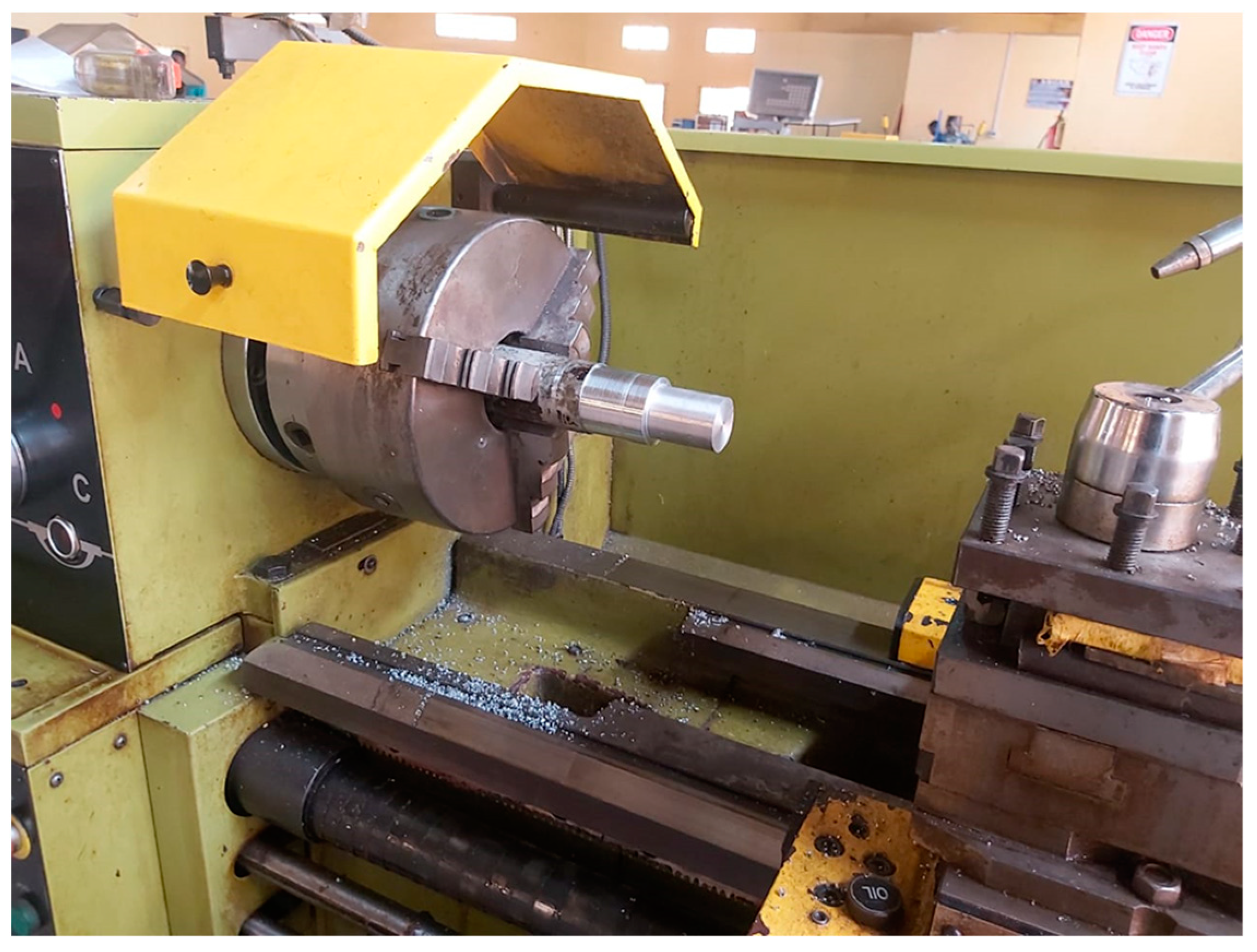
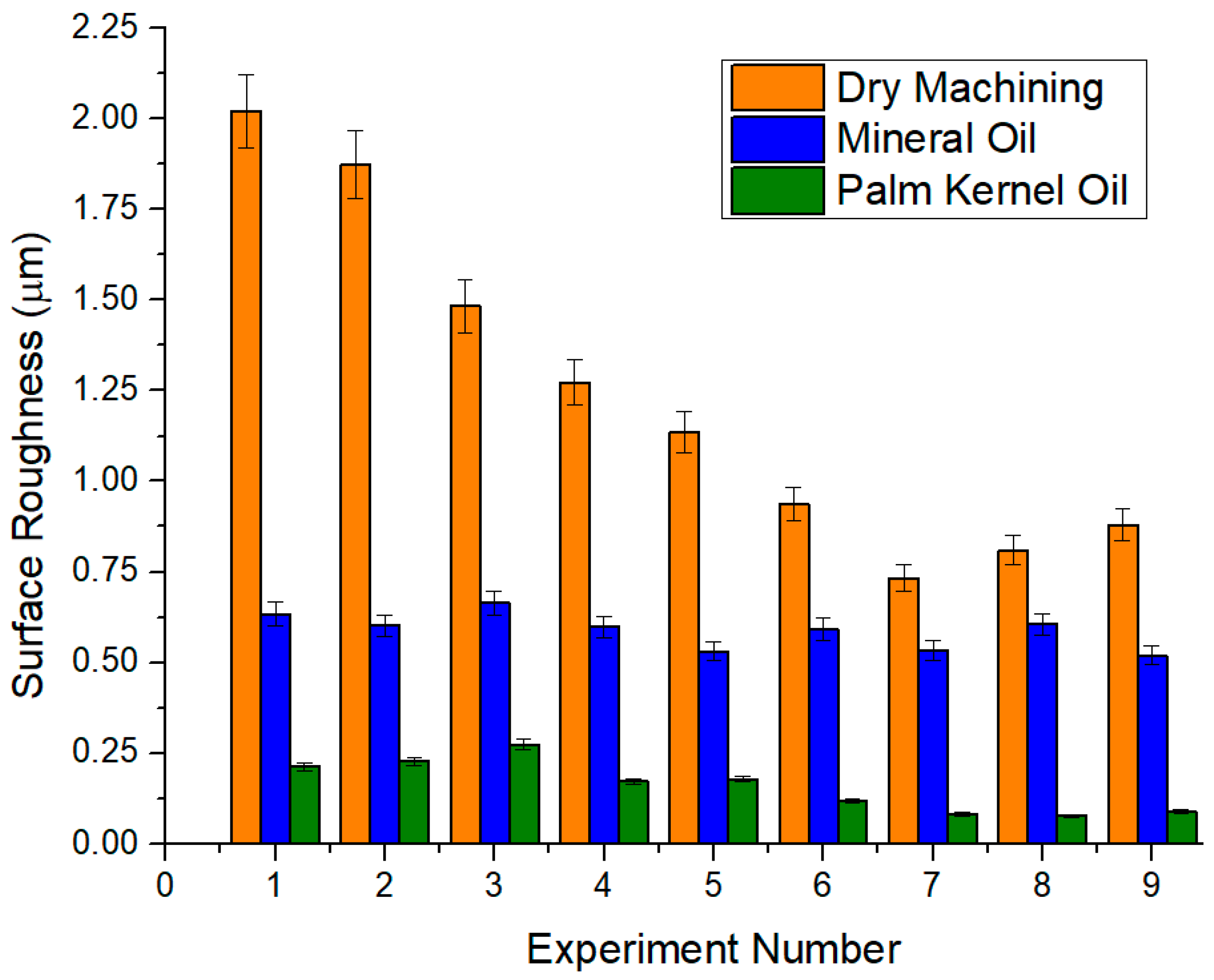
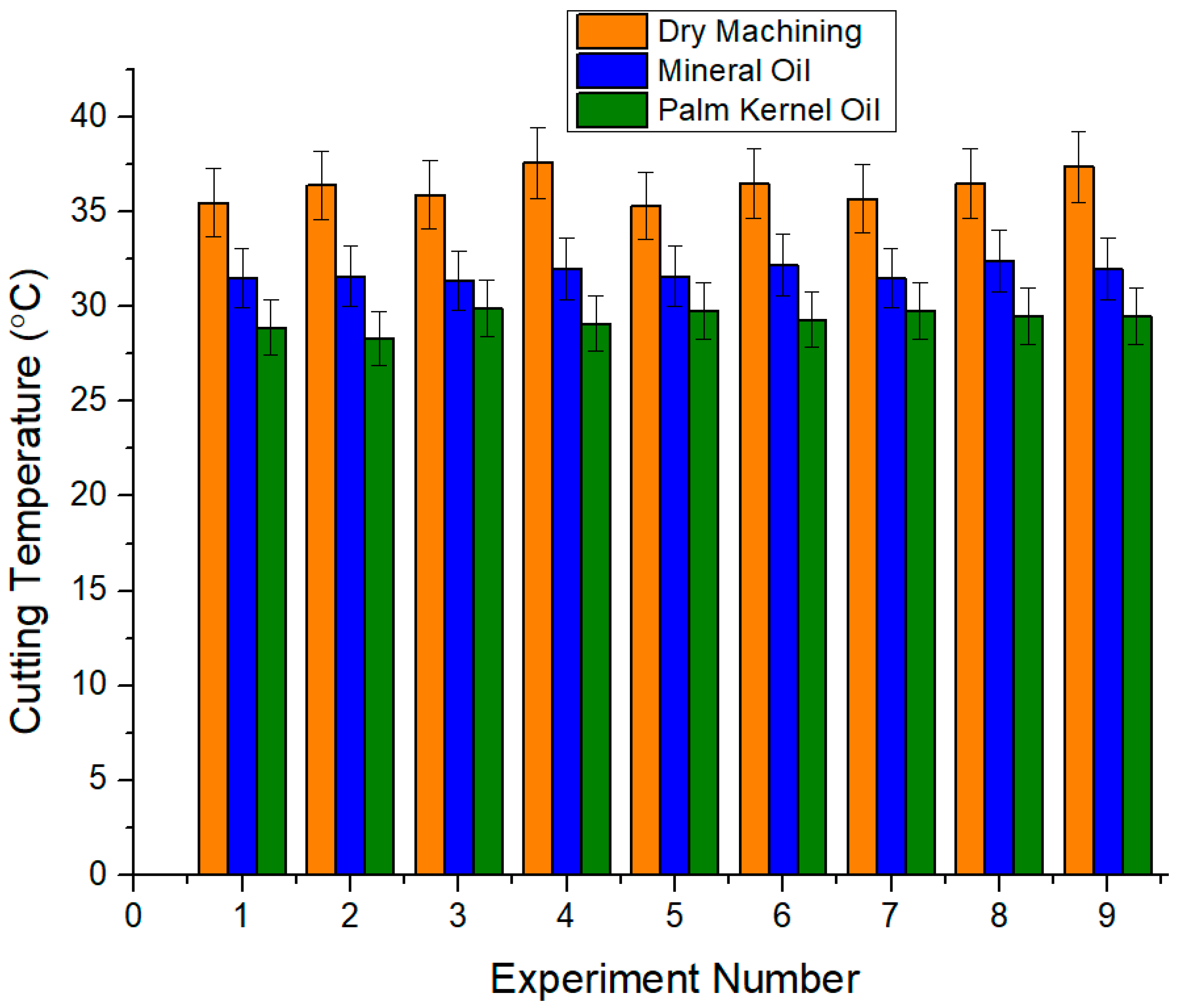

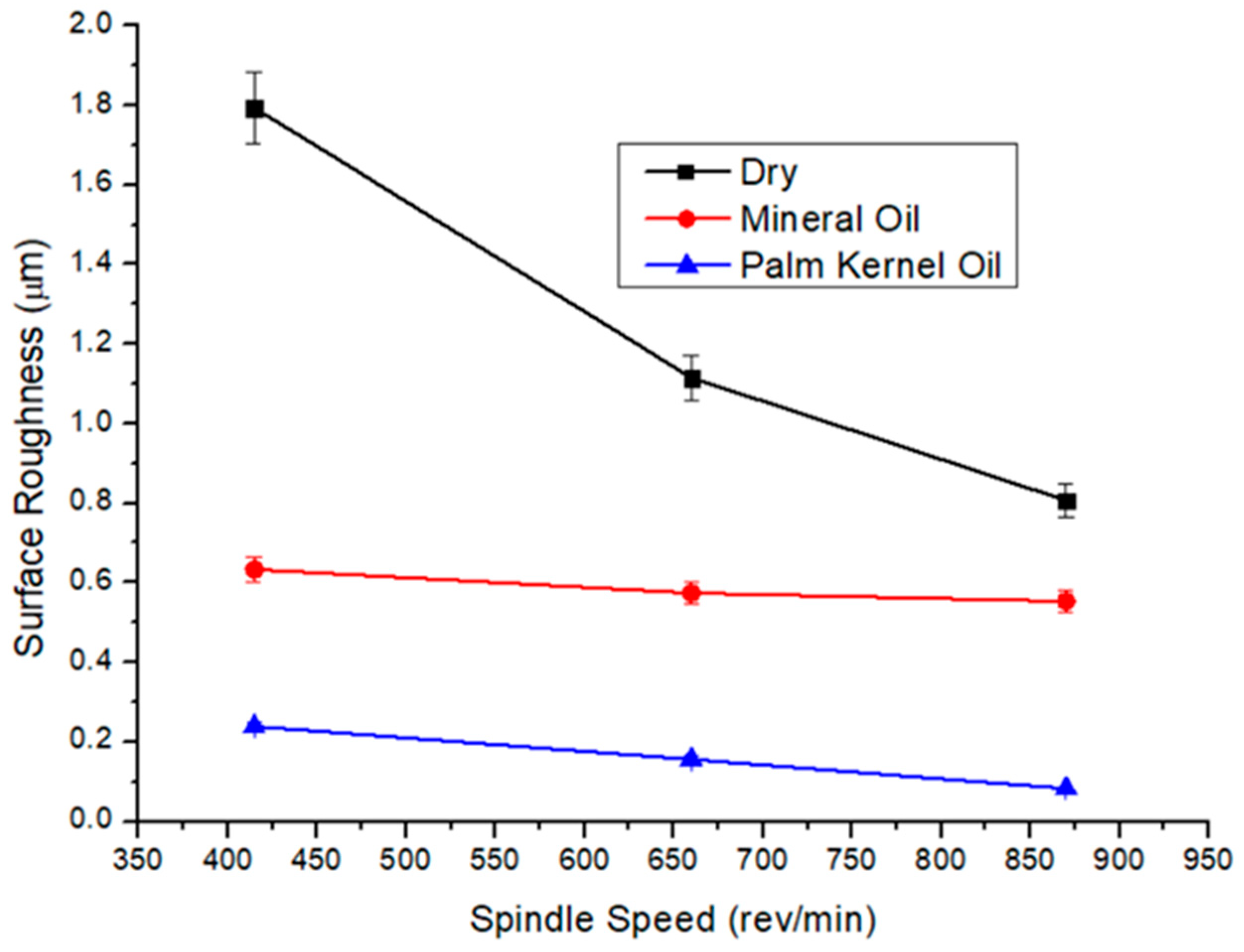
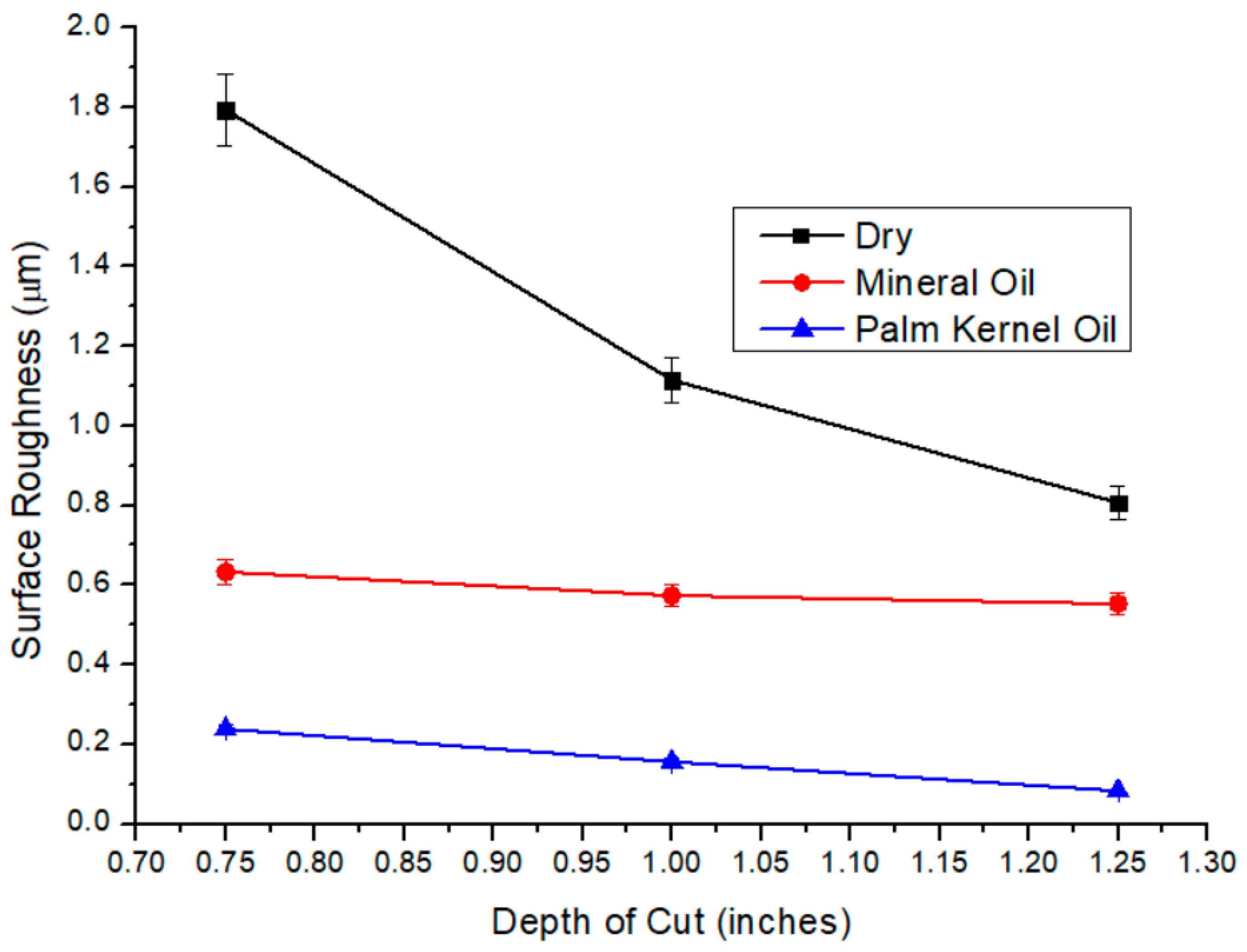
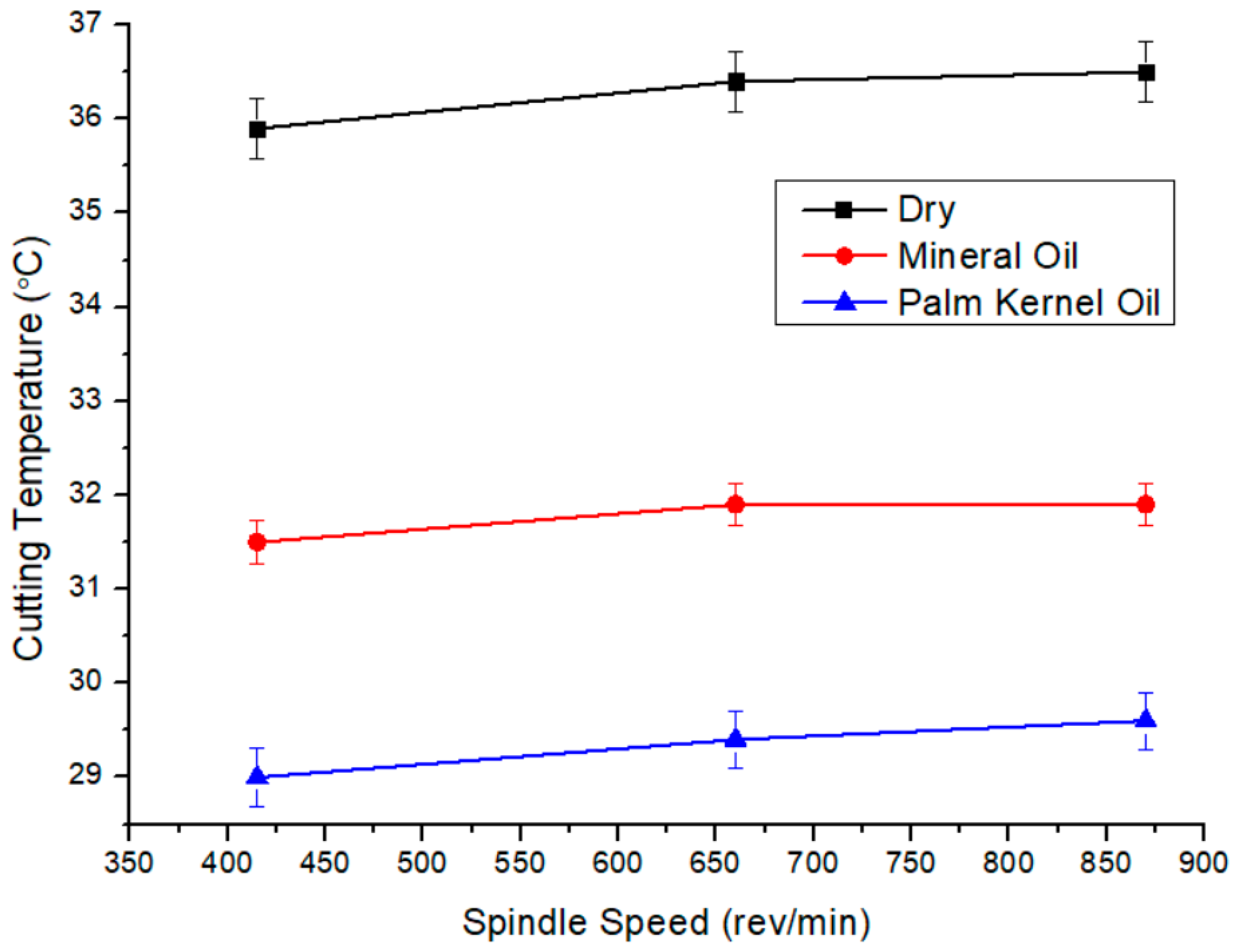


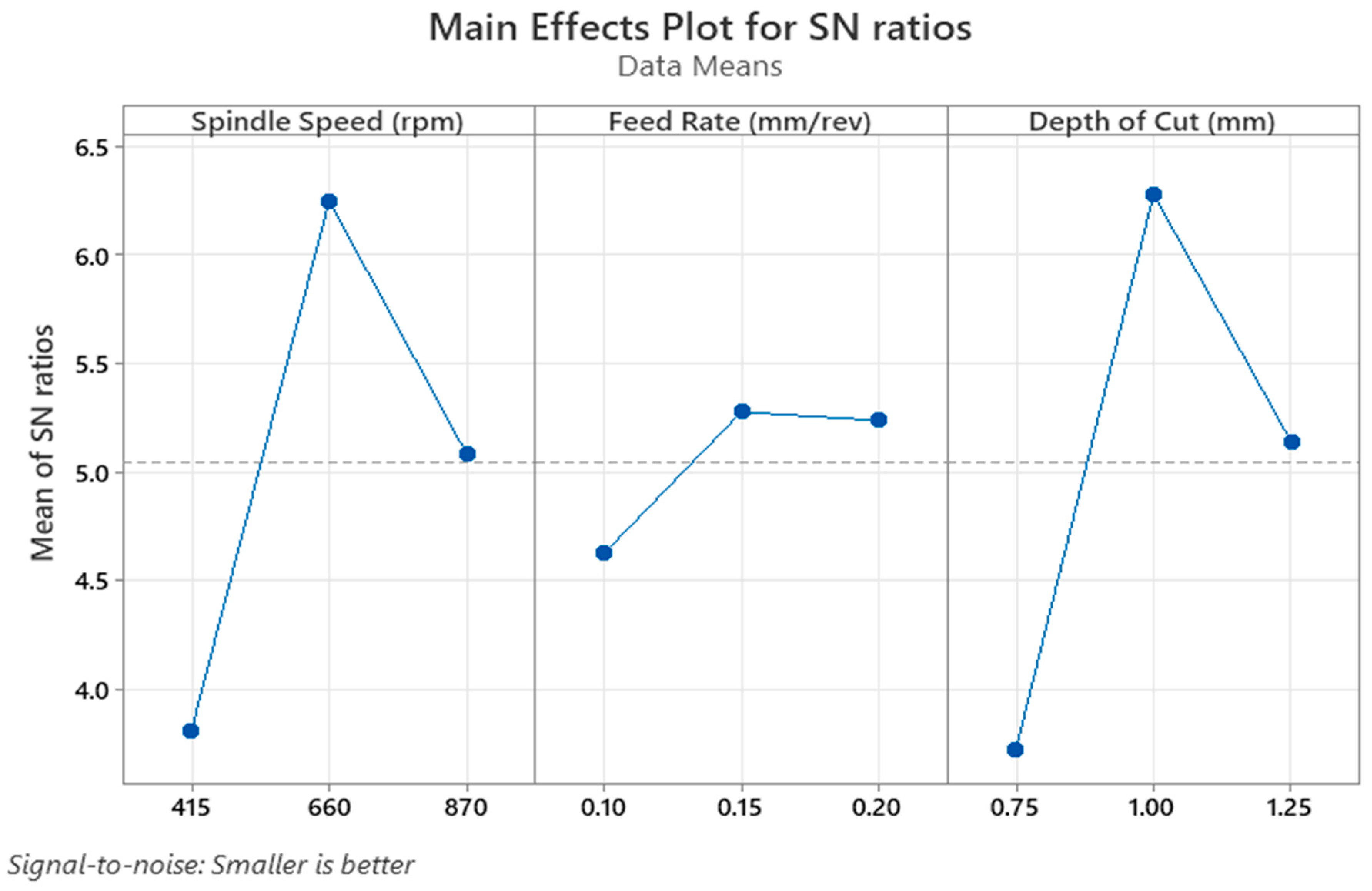
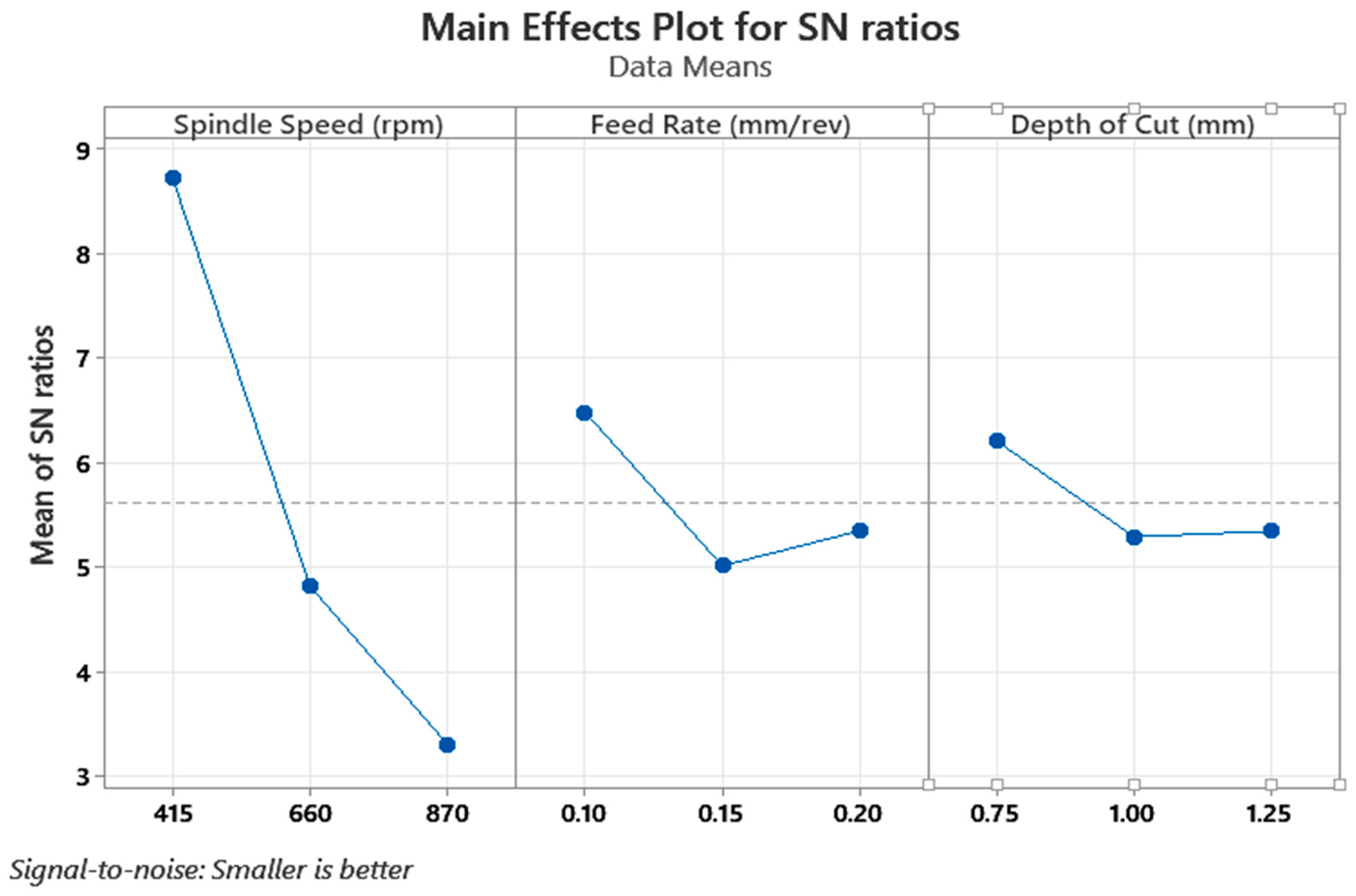

| Property | Reported Value |
|---|---|
| Specific gravity (g) | 0.913 |
| Density (g/cm3) | 0.913 |
| Kinematic viscosity (cP) | 0.264 |
| Cloud point (°C) | −2 |
| Pour point (°C) | −5 |
| Moisture content (%) | 0.42 |
| Acid value (mgKOH/g) | 9.81 |
| FFA (wt, %) | 0.04908 |
| Saponification value (mgKOH/g) | 8.22 |
| PH value | 8.63 |
| Exp. No. | ||||||||
|---|---|---|---|---|---|---|---|---|
| 1 | 0.230 | 0.189 | 0.221 | 0.213 | 28.40 | 28.40 | 30.00 | 28.9 |
| 2 | 0.240 | 0.290 | 0.155 | 0.228 | 28.70 | 28.60 | 27.70 | 28.3 |
| 3 | 0.280 | 0.265 | 0.278 | 0.274 | 30.40 | 29.80 | 29.50 | 29.9 |
| 4 | 0.181 | 0.196 | 0.140 | 0.172 | 28.80 | 29.20 | 29.30 | 29.1 |
| 5 | 0.159 | 0.188 | 0.190 | 0.179 | 29.60 | 29.80 | 29.90 | 29.8 |
| 6 | 0.103 | 0.098 | 0.150 | 0.117 | 29.00 | 29.20 | 29.70 | 29.3 |
| 7 | 0.080 | 0.077 | 0.089 | 0.082 | 30.10 | 29.50 | 29.90 | 29.8 |
| 8 | 0.087 | 0.076 | 0.069 | 0.077 | 29.30 | 29.30 | 30.00 | 29.5 |
| 9 | 0.090 | 0.087 | 0.094 | 0.090 | 29.70 | 29.60 | 29.30 | 29.5 |
| Exp. No. | ||||||||
|---|---|---|---|---|---|---|---|---|
| 1 | 0.590 | 0.670 | 0.642 | 0.634 | 32.80 | 31.80 | 29.90 | 31.5 |
| 2 | 0.650 | 0.576 | 0.579 | 0.602 | 32.40 | 31.90 | 30.40 | 31.6 |
| 3 | 0.680 | 0.660 | 0.651 | 0.664 | 32.20 | 31.70 | 30.30 | 31.4 |
| 4 | 0.555 | 0.580 | 0.662 | 0.599 | 32.80 | 32.40 | 30.90 | 32.0 |
| 5 | 0.683 | 0.407 | 0.502 | 0.531 | 32.00 | 31.80 | 31.10 | 31.6 |
| 6 | 0.623 | 0.598 | 0.554 | 0.592 | 33.10 | 32.70 | 30.90 | 32.2 |
| 7 | 0.540 | 0.493 | 0.569 | 0.534 | 31.80 | 31.60 | 31.10 | 31.5 |
| 8 | 0.574 | 0.590 | 0.650 | 0.605 | 32.90 | 32.60 | 31.70 | 32.4 |
| 9 | 0.580 | 0.403 | 0.576 | 0.520 | 32.50 | 32.30 | 31.20 | 32.0 |
| Exp. No. | ||||||||
|---|---|---|---|---|---|---|---|---|
| 1 | 2.021 | 1.986 | 2.059 | 2.022 | 36.90 | 35.40 | 34.20 | 35.5 |
| 2 | 1.890 | 1.748 | 1.988 | 1.875 | 37.10 | 36.50 | 35.50 | 36.4 |
| 3 | 1.503 | 1.345 | 1.601 | 1.483 | 37.00 | 36.10 | 34.80 | 35.9 |
| 4 | 1.240 | 1.275 | 1.303 | 1.273 | 38.20 | 37.90 | 36.70 | 37.6 |
| 5 | 1.230 | 0.945 | 1.230 | 1.135 | 35.70 | 35.30 | 34.90 | 35.3 |
| 6 | 0.850 | 0.940 | 1.020 | 0.937 | 37.20 | 36.70 | 35.50 | 36.5 |
| 7 | 0.770 | 0.690 | 0.740 | 0.733 | 36.90 | 35.40 | 34.80 | 35.7 |
| 8 | 0.890 | 0.790 | 0.750 | 0.810 | 37.50 | 36.40 | 35.70 | 36.5 |
| 9 | 0.780 | 0.980 | 0.880 | 0.880 | 38.30 | 37.90 | 36.00 | 37.4 |
| Exp. Order | S/N Ratio | Normalized S/N Ratio | Deviation Sequence | GRC | GRG | Order | ||||
|---|---|---|---|---|---|---|---|---|---|---|
| Ra | Cutting Temp. | Ra | Cutting Temp. | Ra | Cutting Temp. | Ra | Cutting Temp. | |||
| 1 | −4.502 | −21.357 | 0.146 | 0.387 | 0.854 | 0.613 | 0.369 | 0.449 | 0.362 | 9 |
| 2 | −4.114 | −21.092 | 0.104 | 0.000 | 0.896 | 1.000 | 0.358 | 0.333 | 0.422 | 6 |
| 3 | −3.155 | −21.776 | 0.000 | 1.000 | 1.000 | 0.000 | 0.333 | 1.000 | 0.374 | 7 |
| 4 | −5.831 | −21.430 | 0.291 | 0.494 | 0.709 | 0.506 | 0.413 | 0.497 | 0.707 | 3 |
| 5 | −5.582 | −21.719 | 0.264 | 0.916 | 0.736 | 0.084 | 0.404 | 0.857 | 0.369 | 8 |
| 6 | −8.683 | −21.517 | 0.601 | 0.621 | 0.399 | 0.379 | 0.556 | 0.569 | 0.531 | 5 |
| 7 | −11.798 | −21.747 | 0.939 | 0.958 | 0.061 | 0.042 | 0.892 | 0.923 | 0.635 | 4 |
| 8 | −12.357 | −21.618 | 1.000 | 0.769 | 0.000 | 0.231 | 1.000 | 0.684 | 0.761 | 2 |
| 9 | −10.903 | −21.618 | 0.842 | 0.769 | 0.158 | 0.231 | 0.760 | 0.684 | 0.807 | 1 |
| Max. | −3.155 | −21.092 | 1.000 | 1.000 | ||||||
| Min. | −12.357 | −21.776 | 0.000 | 0.000 | ||||||
| Delta | ||||||||||
| Exp. Order | S/N Ratio | Normalized S/N Ratio | Deviation Sequence | GRC | GRG | Order | ||||
|---|---|---|---|---|---|---|---|---|---|---|
| Ra | Cutting Temp. | Ra | Cutting Temp. | Ra | Cutting Temp. | Ra | Cutting Temp. | |||
| 1 | −0.392 | −22.449 | 0.152 | 0.101 | 0.848 | 0.899 | 0.371 | 0.357 | 0.364 | 8 |
| 2 | −0.487 | −22.477 | 0.346 | 0.168 | 0.654 | 0.832 | 0.433 | 0.375 | 0.404 | 7 |
| 3 | −0.317 | −22.408 | 0.000 | 0.000 | 1.000 | 1.000 | 0.333 | 0.333 | 0.333 | 9 |
| 4 | −0.495 | −22.668 | 0.363 | 0.636 | 0.637 | 0.364 | 0.440 | 0.579 | 0.509 | 6 |
| 5 | −0.757 | −22.504 | 0.896 | 0.235 | 0.104 | 0.765 | 0.828 | 0.395 | 0.612 | 3 |
| 6 | −0.519 | −22.750 | 0.412 | 0.835 | 0.588 | 0.165 | 0.460 | 0.752 | 0.606 | 4 |
| 7 | −0.742 | −22.449 | 0.866 | 0.101 | 0.134 | 0.899 | 0.789 | 0.357 | 0.573 | 5 |
| 8 | −0.477 | −22.817 | 0.326 | 1.000 | 0.674 | 0.000 | 0.426 | 1.000 | 0.713 | 2 |
| 9 | −0.808 | −22.655 | 1.000 | 0.603 | 0.000 | 0.397 | 1.000 | 0.557 | 0.779 | 1 |
| Max. | −0.317 | −22.408 | 1.000 | 1.000 | ||||||
| Min. | −0.808 | −22.817 | 0.000 | 0.000 | ||||||
| Delta | ||||||||||
| Exp. Order | S/N Ratio | Normalized S/N Ratio | Deviation Sequence | GRC | GRG | Order | ||||
|---|---|---|---|---|---|---|---|---|---|---|
| Ra | Cutting Temp. | Ra | Cutting Temp. | Ra | Cutting Temp. | Ra | Cutting Temp. | |||
| 1 | −0.935 | −24.032 | 1.000 | 0.089 | 0.000 | 0.911 | 1.000 | 0.354 | 0.725 | 1 |
| 2 | −0.746 | −24.358 | 0.796 | 0.469 | 0.204 | 0.531 | 0.710 | 0.485 | 0.522 | 5 |
| 3 | −0.293 | −24.208 | 0.307 | 0.295 | 0.693 | 0.705 | 0.419 | 0.415 | 0.710 | 2 |
| 4 | −0.110 | −24.812 | 0.110 | 1.000 | 0.890 | 0.000 | 0.360 | 1.000 | 0.428 | 9 |
| 5 | −0.030 | −23.956 | 0.024 | 0.000 | 0.976 | 1.000 | 0.339 | 0.333 | 0.598 | 4 |
| 6 | −0.008 | −24.395 | 0.000 | 0.513 | 1.000 | 0.487 | 0.333 | 0.507 | 0.451 | 8 |
| 7 | −0.181 | −24.108 | 0.187 | 0.177 | 0.813 | 0.823 | 0.381 | 0.378 | 0.652 | 3 |
| 8 | −0.084 | −24.420 | 0.082 | 0.542 | 0.918 | 0.458 | 0.353 | 0.522 | 0.518 | 6 |
| 9 | −0.031 | −24.739 | 0.025 | 0.915 | 0.975 | 0.085 | 0.339 | 0.854 | 0.512 | 7 |
| Max. | −0.008 | −23.956 | 1.000 | 1.000 | ||||||
| Min. | −0.935 | −24.812 | 0.000 | 0.911 | ||||||
| Delta | ||||||||||
| Environment. | Source | DF | Adj SS | Adj MS | F-Value | % |
|---|---|---|---|---|---|---|
| Mineral oil | 2 | 0.159098 | 0.079549 | 20.52 | 0.046 | |
| 2 | 0.017069 | 0.008534 | 2.20 | 0.312 | ||
| 2 | 0.006384 | 0.003192 | 0.82 | 0.548 | ||
| Error | 2 | 0.007754 | 0.003877 | |||
| Total | 8 | 0.190305 | ||||
| Palm kernel oil | 2 | 0.183287 | 0.091643 | 10.35 | 0.088 | |
| 2 | 0.005449 | 0.002725 | 0.31 | 0.765 | ||
| 2 | 0.051858 | 0.025929 | 2.93 | 0.255 | ||
| Error | 2 | 0.017706 | 0.008853 | |||
| Total | 8 | 0.258300 | ||||
| Dry machining | 2 | 0.038462 | 0.019231 | 4.53 | 0.181 | |
| 2 | 0.005185 | 0.002593 | 0.61 | 0.621 | ||
| 2 | 0.041318 | 0.020659 | 4.87 | 0.170 | ||
| Error | 2 | 0.008484 | 0.004242 | |||
| Total | 8 | 0.093449 |
Disclaimer/Publisher’s Note: The statements, opinions and data contained in all publications are solely those of the individual author(s) and contributor(s) and not of MDPI and/or the editor(s). MDPI and/or the editor(s) disclaim responsibility for any injury to people or property resulting from any ideas, methods, instructions or products referred to in the content. |
© 2025 by the authors. Licensee MDPI, Basel, Switzerland. This article is an open access article distributed under the terms and conditions of the Creative Commons Attribution (CC BY) license (https://creativecommons.org/licenses/by/4.0/).
Share and Cite
Ikumapayi, O.M.; Laseinde, O.T.; Kazeem, R.A.; Onu, P.; Ting, T.T. The Development and Performance Assessment of Palm Kernel Nut Oil as a Cutting Fluid for the Turning of AA6061. Lubricants 2025, 13, 279. https://doi.org/10.3390/lubricants13070279
Ikumapayi OM, Laseinde OT, Kazeem RA, Onu P, Ting TT. The Development and Performance Assessment of Palm Kernel Nut Oil as a Cutting Fluid for the Turning of AA6061. Lubricants. 2025; 13(7):279. https://doi.org/10.3390/lubricants13070279
Chicago/Turabian StyleIkumapayi, Omolayo M., Opeyeolu T. Laseinde, Rasaq A. Kazeem, Peter Onu, and Tin T. Ting. 2025. "The Development and Performance Assessment of Palm Kernel Nut Oil as a Cutting Fluid for the Turning of AA6061" Lubricants 13, no. 7: 279. https://doi.org/10.3390/lubricants13070279
APA StyleIkumapayi, O. M., Laseinde, O. T., Kazeem, R. A., Onu, P., & Ting, T. T. (2025). The Development and Performance Assessment of Palm Kernel Nut Oil as a Cutting Fluid for the Turning of AA6061. Lubricants, 13(7), 279. https://doi.org/10.3390/lubricants13070279






